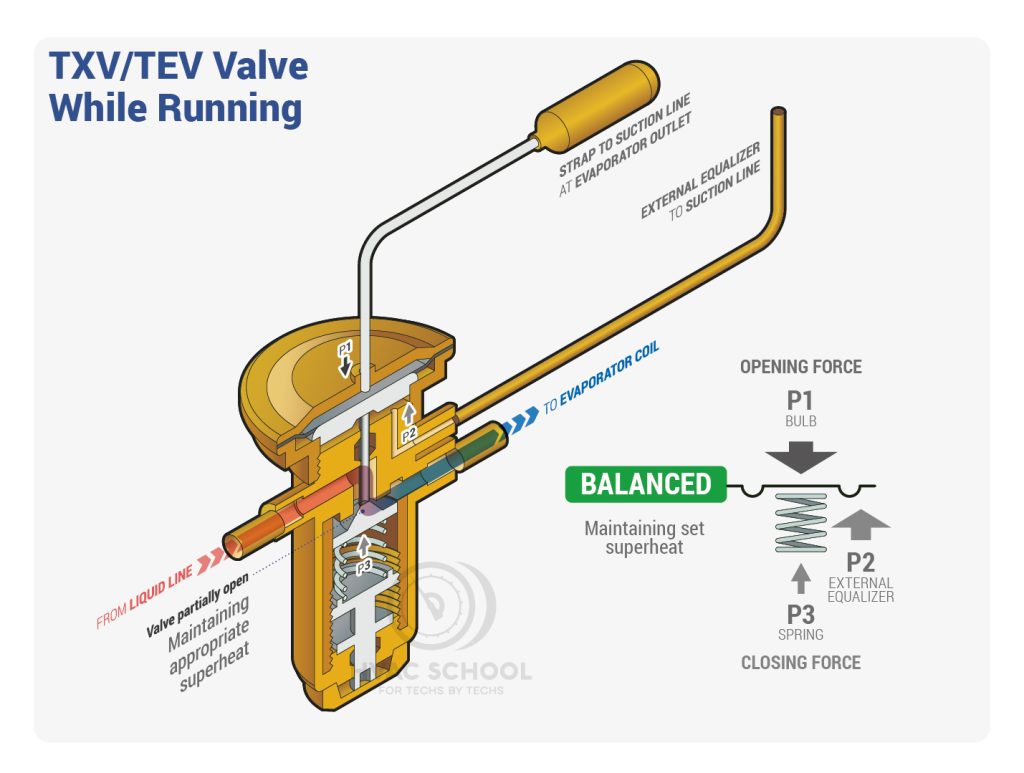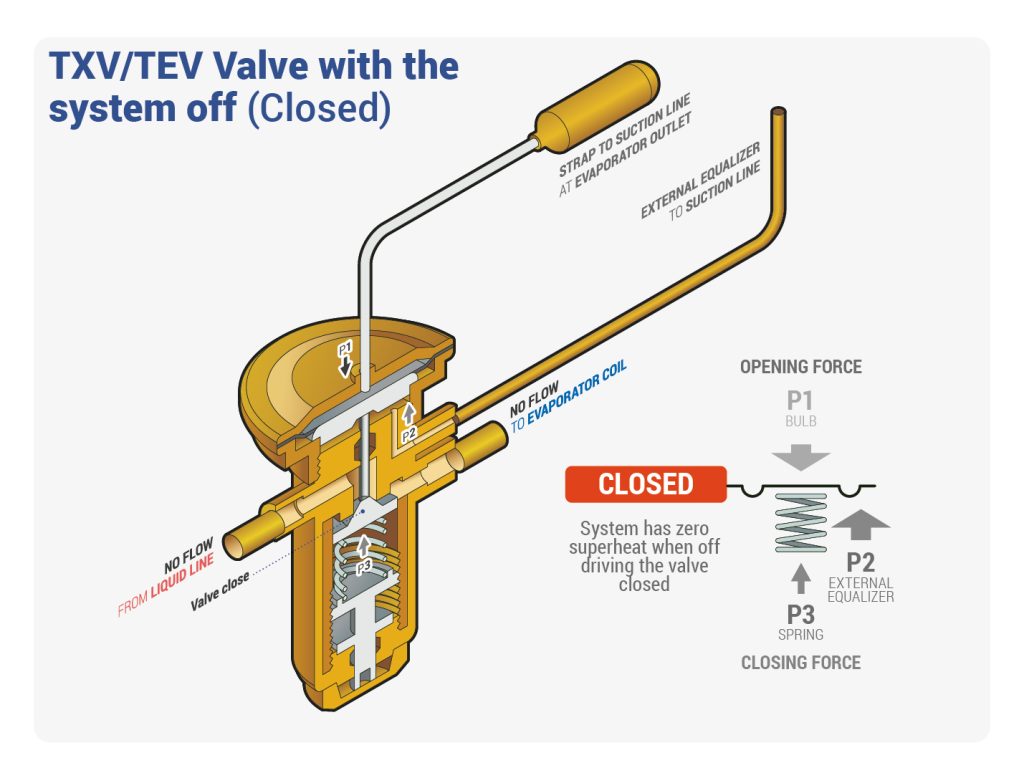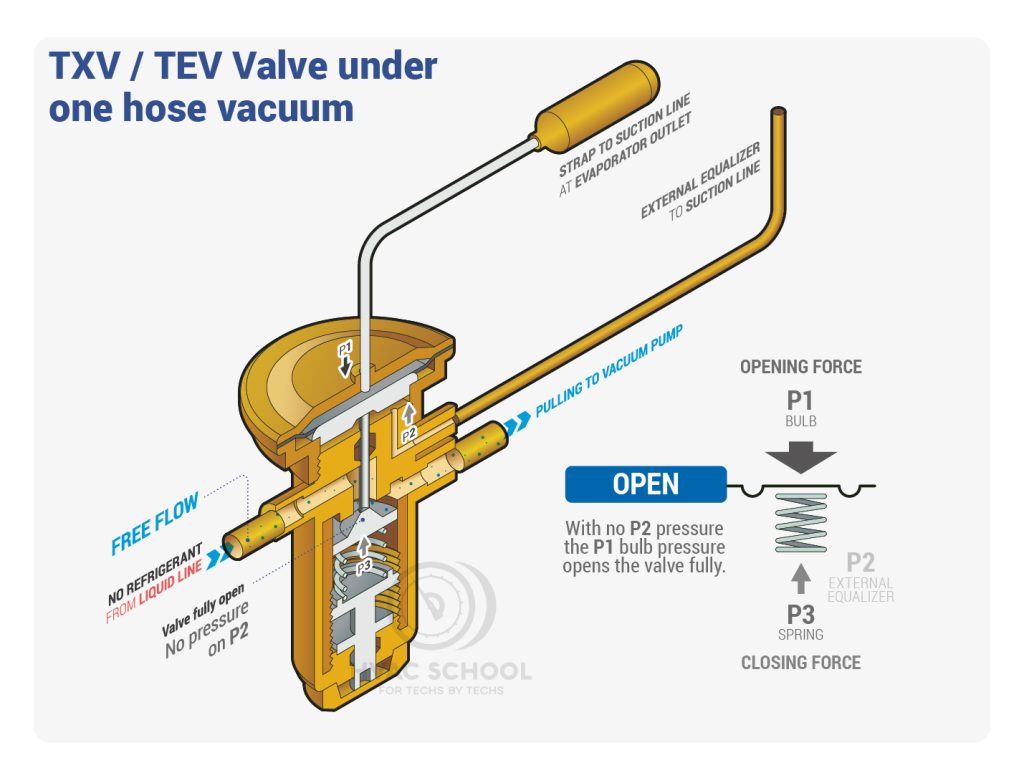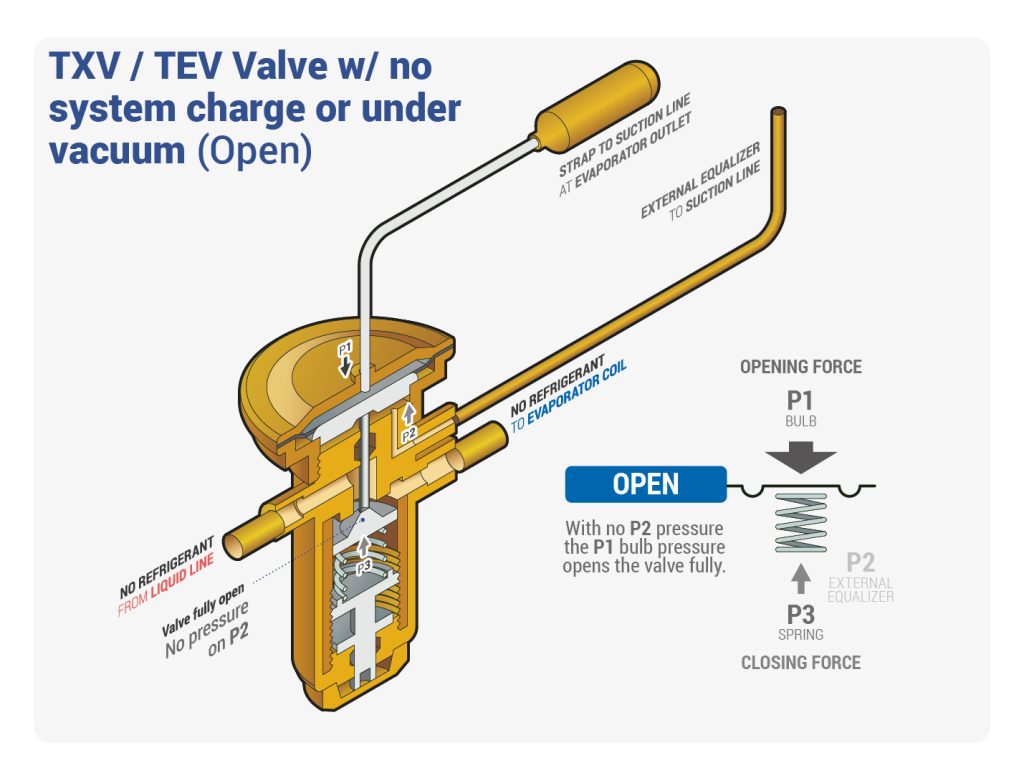Get Tech Tips
Subscribe to free tech tips.
What is a HSO (Non-Bleed) TXV/TEV?

There is a lot of misunderstanding about the HSO (hard shut-off) or “non-bleed” TXV (thermostat expansion valve) and what makes it shut off, why it exists, and how it “magically” opens.
Once you understand the forces inside the valve, it is quite simple, obvious, and sadly devoid of any magic.
The Three Forces
The TXV has two primary closing forces: the evaporator pressure via the internal or external equalizer (depending on the valve type) and the spring pressure. It also has one opening force: the bulb/powerhead pressure.
The bulb is mounted on the suction line, so the warmer the suction line, the wider the valve will open if the evaporator pressure remains the same. The colder the suction line, the more the valve will close if the evaporator pressure remains the same.
Most modern valves are externally equalized with the suction/evaporator pressure at the outlet of the evaporator, so the higher the suction pressure, the more the valve will close if the suction temperature remains the same. The lower the suction pressure, the more the valve will open if the suction pressure remains the same.
Said more simply:
The bulb is the opening force, and the spring and external equalizer are both closing forces

These two forces balance during operation, with the spring adding some additional force so that the superheat can be set and maintained by the valve (to some degree). Without the pressure of the superheat spring assisting the external equalizer, the pressures in the bulb and pressure in the evaporator will exert the same force, failing to modulate and control the superheat. That means that the temperature of the suction line needs to be greater than the saturation pressure in the coil.
That occurs while running because the refrigerant is dynamically moving. As the valve adjusts, the coil, pressures, and temperature also change until a balance of the three forces is achieved. Then, the valve settles in on its designed superheat.

What is the Superheat When The System is Off?
This is not a trick question. What is the superheat of a system when it isn't running? The answer is ZERO.
When the compressor goes off, and the refrigerant becomes static (still) instead of dynamic (moving), the pressures in the evaporator coil begin to rise as the liquid and vapor in the coil reach equilibrium with the temperature until zero superheat (also called saturation) is reached.
So, what does the valve do? It CLOSES.

It doesn't need to be a SPECIAL hard shut-off valve; it just does what it is designed to do, and when you look at the forces that make it open and close, it makes complete sense.
When the refrigerant stops flowing, the coil starts to warm up, the coil pressure starts to go up, and both the bulb and external equalizer forces rise equally. However, without refrigerant flow driven by the compressor pulling down the pressure in the suction line, the valve shuts due to the spring pressure.
In other words, unless a TXV is specifically DESIGNED not to close all the way, it stands to reason that it will start closing as soon as the compressor goes off and eventually shut completely once the evaporator pressure rises to the point that the saturated pressure + spring pressure is greater than the bulb saturated temperature.
Clear as mud? Let me describe it in two practical ways you may have observed.
The Nitrogen Observation
When I pressurize a new split system with nitrogen, I like to feed it in the liquid line and watch the suction rise to ensure there are no restrictions in the system and, hopefully, to force any contaminants into the filter/drier or screen rather than the valve.
I always noticed that on a TXV system, I could only pressurize it so far before the suction pressure stopped increasing. It always worked fine up to a certain point, but once I got somewhere between 200 and 300 PSIG on an R410a system, the suction would just stop rising.
Have you ever noticed that? Ever wonder why?
Take a look at a PT chart. You will notice that the pressure “shuts off” and will often be right around the saturation temperature of the refrigerant the valve is designed for at the current indoor temperature.
The example below shows the saturation pressure of R410a with an 80-degree coil. Notice the pressure is often about where the valve shuts off on you when pressurizing.

That happens because the system is off and because the bulb pressure (opening force) is at approximately the indoor temperature when the suction line is around the indoor temperature.
Initially, the valve is wide open when the coil has no pressure because the external equalizer exerts very little closing force. As you add pressure to the coil, the force exerted by the external equalizer increases to the point until you get near that saturation pressure—and WHAM—the valve shuts.
Vacuum on the Suction Side

When we first started advocating for pulling a vacuum with one hose on the suction side with the vacuum gauge on the liquid line, many thought it wouldn't work because of “hard shut-off TXVs.”
That is true of closed solenoids or shut ELECTRONIC expansion valves but NOT of a non-bleed TXV. “Why?” you might ask.
Think about the forces again.
When we pull a vacuum, we are DROPPING pressure—in this case, on the suction line. When we decrease suction line pressure, we also decrease the external equalizer force, which closes the valve.


When you decrease a closing force, you open the valve further, so pulling a vacuum in this way actually drives the valve open. We have shown time and time again that it is a very effective method of pulling a deep vacuum for residential new installs and changeouts.
What is Hard Shut-Off Good For?
The advantage of a non-bleed TXV is simple: it helps reduce refrigerant migration and flooded starts. By closing soon after the system cycles off, the valve keeps most of the refrigerant in the condenser coil, which prevents it from gathering in the compressor or dumping down the suction line when the system comes on. Since compressors can be easily damaged by floodback, the non-bleed TXV is a good thing for that reason.
The only thing that causes trouble is the fact that some compressors struggle to start with more pressure on the discharge side and less on the suction side; this is why some manufacturers require hard start gear when an HSO/non-bleed valve is in place.
—Bryan











Comments
Amazing article. Here in the UK I was arguing with my college teacher through my 5 day course that TXVs open up with higher superheat which he adamantly told me in front of the class that they don’t, his argument was based on the fact that they close when the system is turned off. Which I could not explain until reading this. Great to learn something new. I am now qualified and owe Bryan a lot through the literal listening of 100+ hours of your podcasts. Thank you
Amazing article. Here in the UK I was arguing with my college teacher through my 5 day course that TXVs open up with higher superheat which he adamantly told me in front of the class that they don’t, his argument was based on the fact that they close when the system is turned off. Which I could not explain until reading this. Great to learn something new. I am now qualified and owe Bryan a lot through the literal listening of 100+ hours of your podcasts. Thank you
To leave a comment, you need to log in.
Log In